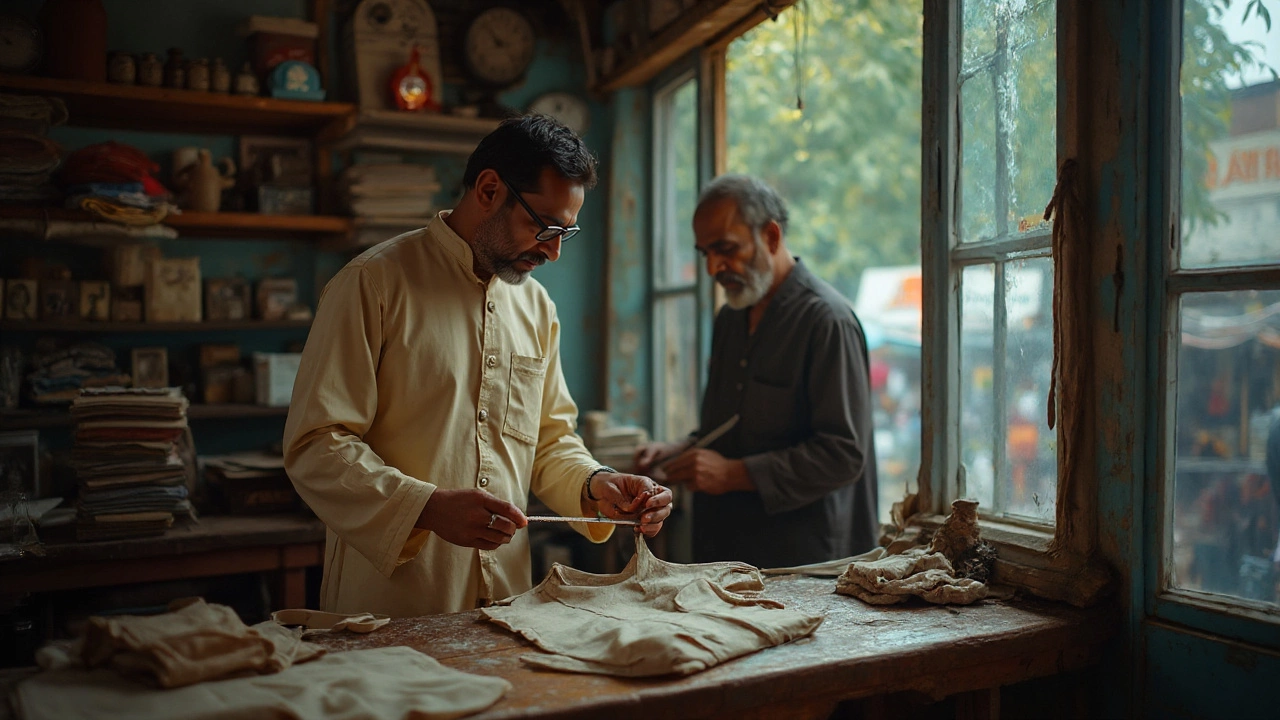That old suit in the wardrobe isn’t dead weight. It’s fabric, form, and history you can put back to work. Whether it belonged to your dad, grandad, or it’s just a dated cut, you’ve got four real paths: wear it again with tweaks, pass it on to someone who needs it, turn it into something useful, or cash it out. You won’t do all of these today, so here’s a no-drama way to pick one, act on it, and feel good about the outcome.
TL;DR: Quick answers and what to do today
You clicked because you want options and a plan, not a lecture. Here are the fast routes, then we’ll go step by step.
- Good condition and quality brand? Sell it or tailor it. A quick press, new buttons, and tapered trousers can make it wearable now.
- Decent but not your style? Donate it to a local op shop or a community wardrobe so it gets used for interviews, school balls, or events.
- Damaged or dated? upcycle suit fabric into a tote, cushion, cap, dog bed, apron, or kids’ waistcoat. Plenty of easy patterns work with suiting.
- Sentimental piece? Save the best panels for a memory cushion, photo-frame mat, or quilt square; keep a label or pocket as a keepsake.
- Unsure? Start with a clean, a condition check, and one small fix (like resewing a loose hem). That alone can unlock your decision.
Jobs you likely want to get done today:
- Figure out what the suit is worth and which path makes sense.
- Get a simple checklist to assess condition fast.
- See easy DIY projects that don’t need a fancy sewing room.
- Know where to donate or sell in New Zealand and what they accept.
- Avoid common mistakes (shrinking wool, wrecking canvassed jackets, cutting before measuring).
Step-by-step: Assess, choose, and act
Start with the fabric and the condition. This decides 80% of what you should do.
1) Identify fabric and construction
- Check the inside tag: “100% wool” or “wool blend” is ideal. Polyester-heavy blends are tougher, but great for bags or aprons.
- Hold the jacket front between fingers. If it feels like a firm layer inside, it’s canvassed or fused. Canvassed jackets are higher quality and worth tailoring or selling.
- Look for damage: shine on elbows, moth holes near seams, stretched knees on trousers, or sweat staining under arms.
2) Quick freshen-up
- Steam before you judge. A handheld steamer can lift wrinkles and revive wool. If no steamer, hang it in a steamy bathroom and brush with a soft clothes brush.
- Dry-clean wool suits if they smell musty or have set-in stains. In Auckland (2025), expect about NZ$18-35 per piece at most cleaners.
- De-pill with a fabric shaver and replace missing buttons with a matched set.
3) Decide with a simple rule
- If it’s quality wool, still fits or can be made to fit, and you like it: tailor it to modern proportions.
- If it’s quality, doesn’t fit you, but is presentable: sell or donate.
- If it’s damaged but has usable panels: repurpose into accessories or home items.
- If it’s very worn or moth-eaten throughout: harvest what you can, then responsibly dispose of the rest.
4) Tailoring: quick wins for 2025 silhouettes
- Buttons: Swap plastic for horn or matte corozo. Dark tortoiseshell works on navy or charcoal. This alone updates the look.
- Trousers: A slight taper helps, but don’t go skinny; the 2025 look is relaxed. If they’re too skinny, let out the seams.
- Jacket: Have a tailor clean up the waist a touch, shorten sleeves to show 1 cm of shirt cuff, and press a softer lapel roll. Avoid major shoulder changes-they’re risky and costly.
- Fit targets: Jacket closes without pulling, lapels lay flat, back is smooth, and trousers break lightly on the shoe.
- Budget in Auckland: Sleeve hems NZ$25-45, trouser taper/hem NZ$35-60, jacket waist suppression NZ$60-120. Prices vary by shop and fabric.
5) Selling: set expectations
- Good brands move: look for labels like Zegna, Canali, Hugo Boss, Rodd & Gunn, or high-end made-to-measure. Clean, pressed, with clear photos.
- Note the tag size, fabric, and any tailor marks. Photograph in daylight against a clean wall. Include jacket laid flat (shoulder-to-shoulder, pit-to-pit, sleeve length) and trouser waist/inseam.
- Prices (NZ, secondhand): NZ$30-250 for most suits; more if near-new or top brand. If it lingers for weeks, drop the price or try a different platform.
6) Donating: where it actually helps
- Op shops that commonly accept suits: Red Cross Shops, Salvation Army Family Stores, Hospice shops, SaveMart. Drop off clean and on a hanger if you can.
- Community and special events: local school ball drives, drama departments, and community wardrobes often need suits for formals and performances.
- Tip: Pin a note with size and fabric (e.g., “40R jacket, 34W trousers, wool-blend”). It speeds rehoming.
7) If the suit is sentimental
- Keep the label, inside pocket, or lining pattern for a memory frame or a bookmark.
- Make a cushion with the jacket front (use the pockets for remote storage). Add the original buttons to keep the story.
- Turn the tie (if you have it) into a glasses case or a skinny headband for a keepsake that’s used daily.
Why bother at all? Two reasons. First, suiting fabric-especially wool-wears for years. Second, extending a garment’s life by nine months can cut its carbon, water, and waste footprint by 20-30% (WRAP, UK). In New Zealand, industry groups have flagged six-figure tonnes of textiles heading to landfill each year. Keeping one suit in circulation is a small but real dent.

Ideas and how-tos: turn one suit into many useful things
You don’t need a fashion degree or a full workshop. A basic kit-sharp scissors, chalk, pins, hand needle, matching thread, iron/steamer, and a cheap unpicker-covers most of this. If you own a sewing machine, great. If not, several of these are no-machine projects.
1) Modern blazer, casual vibe
- Remove the matching trousers from the equation. Wear the jacket with jeans or chinos and a tee. Swap to textured buttons (matte horn).
- Have a tailor relax the waist a touch instead of slimming it. 2025 tailoring is more boxy and comfortable.
- Pair with clean sneakers or loafers. You’ve just gained a smart-casual jacket.
2) Chore-jacket conversion (intermediate)
- Unpick the shoulder pads and sleeve heads carefully to soften structure.
- Close or remove the vents; square off hem slightly if it’s very curved.
- Add patch pockets from the trouser fabric. Swap to chunky buttons and bar-tack stress points.
- Result: a workwear-style jacket with the drape of suiting-great over tees or knits.
3) Waistcoat from jacket (intermediate)
- Mark a vest shape on the jacket front, keeping the internal pocket if you can. Cut and bind the raw edges with bias tape (use the lining to make it).
- Finish the arm and neck openings neatly. Add three buttons down front.
- Works well layered over shirts or dresses; sharp for events.
4) Trousers to tote bag (easy)
- Cut the legs off at the thigh, sew bottoms closed, and stitch both legs together side-by-side to form a roomy rectangle.
- Use the waistband as a decorative top trim. Make handles from old belts or leftover fabric folded into straps.
- Line with an old pillowcase for strength. Good grocery or library bag.
5) Flat cap or bucket hat (intermediate)
- Use a printed pattern (many free options) and fuse a light interfacing to keep the shape.
- Suiting takes curves nicely. Lining can be the suit’s original satin.
- Great way to keep a piece of someone’s style in everyday wear.
6) Memory cushion with working buttons (easy)
- Cut a 45x45 cm square from the jacket front so the buttons and pocket sit centered.
- Back it with the lining or a contrasting cotton. Insert cushion inner, close with the jacket’s buttons. No zips needed.
7) Garment brush and shoe-shine kit roll (easy)
- Use sturdy trouser fabric to sew a simple roll with pockets for a brush, cloth, and polish tin.
- Close with a strip cut from the waistband or a tie loop.
8) Apron (easy)
- Cut an apron shape from the back of the jacket or trouser legs. Bind edges with bias tape.
- Use the trouser back pocket as a front pouch. Add neck and waist ties.
9) Kidswear mini-waistcoat (intermediate)
- Small bodies, big impact. Trace a simple kids’ vest on paper, then cut from the jacket panels.
- Bind edges and reuse small buttons. Cute for school performances or weddings.
10) Sleeve wine bag (easy)
- Slip a wine bottle into a jacket sleeve, cut to length, and sew the bottom shut.
- Add a handle made from the sleeve cuff. Smart host gift.
11) Tech sleeve or glasses case (easy)
- Use the softer lining for the inside and suiting for the outside. Add a layer of felt for padding.
- A button-and-loop closure keeps it simple and classic.
12) Dog bed stuffing and patchwork top (easy)
- If the suit is too far gone, wash, dry, and shred the fabric into stuffing for a pet bed, or cut intact panels for the top cover.
- Sturdy and washable; great for the garage or laundry.
Want a quick way to choose? Compare time, cost, and skill at a glance:
| Option | Time | Cost (NZ$) | Skill Level | Potential Value Saved/Earned |
|---|---|---|---|---|
| Tailor jacket + trousers | 2-7 days (tailor) | 120-220 | Pro service | Wearable suit; replaces 400-800+ new |
| Sell (clean + list) | 1-2 hours + wait | 0-35 (clean) | Beginner | 30-250 cash |
| Donate (clean + drop) | 1-2 hours | 0-35 | Beginner | High social impact |
| Tote bag (trousers) | 1-2 hours | 0-10 | Easy | Replaces 20-40 bag |
| Memory cushion | 1-2 hours | 0-15 | Easy | Sentimental, giftable |
| Chore-jacket conversion | 3-6 hours | 0-20 | Intermediate | Stylish outer layer |
| Hat (flat cap/bucket) | 3-4 hours | 0-15 | Intermediate | 50-120 retail equivalent |
Notes: Costs are materials only, not your time. 2025 Auckland tailoring and cleaning ranges are typical but vary by suburb and shop.
Environmental side-note: Wool and wool-blends last and repair well. Textile industry groups in NZ have highlighted large volumes of clothing going to landfill. Keeping a suit in use-either worn, resold, or remade-stretches its value and reduces waste. WRAP (UK) reports that prolonging a garment’s active life is one of the most effective levers for cutting its footprint.
Checklists, pitfalls, and your most likely questions
Here’s the quick-reference section you’ll actually use. Save it, screenshot it, hand it to your future self.
Condition checklist (5-minute scan)
- Fabric: Any moth holes, shines, or thin patches? Elbows, cuffs, seat are hotspots.
- Smell: Musty or smoky? Plan a dry clean or a long air-out.
- Fit: Try jacket buttoned; any pulling at button or collar gap at the neck?
- Buttons/zip: Missing or loose? Note how many you need.
- Lining: Torn at the armpits or vents? Easy fix, but count it.
- Trousers: Waist size vs your waist today; hem wear at the back?
Decision mini-flow
- Clean and steam. Looks decent now? Continue. Looks tired beyond saving? Go to Repurpose.
- Check fabric (prefer wool) and quality. Good? Tailor/Sell/Donate. Poor? Repurpose.
- If sentimental, split: keep best panels for a keepsake, repurpose the rest.
Repurpose starter kit
- Tools: Scissors, seam ripper, chalk, pins, needle, thread, iron/steamer.
- Safety: Cut away from fingers, mind hot irons, and keep pins in a jar.
- First cut rule: Measure twice, cut once; test on a scrap from the hem before committing.
Pitfalls to avoid
- Don’t wash a wool suit in hot water; it can shrink and felt. If you must hand-wash, cold water only and lay flat to dry.
- Don’t try to change shoulder width. That’s a major surgical job even for pros.
- Don’t ignore moths. Freeze the suit in a sealed bag for 72 hours to kill larvae before bringing it near other clothes.
- Don’t cut through canvassing blindly. Unpick linings first and trace your pattern.
- Don’t donate stained or smelly items. Shops spend time and money sorting; give them a fair shot.
FAQ: your likely follow-ups
- Is a very old, heavy suit still wearable? Yes, with tweaks. Heavy wool wears great in winter. Pair the jacket with denim and boots to balance the weight.
- How do I know if it’s worth tailoring? If it’s good wool, feels structured but not stiff, and fits your shoulders, it’s a candidate. Shoulders are the line you can’t easily change.
- Can I dye a suit? Not recommended for tailored pieces-interfacings and thread often won’t take dye evenly. Better to change buttons and styling.
- What about suits with shiny elbows or seat? If everything else is solid, patch from the inside with matching fabric and wear casually. Or cut around the shine for smaller projects.
- Where should I donate in NZ? Red Cross Shops, Salvation Army Family Stores, Hospice shops, and larger thrift stores like SaveMart usually accept suits. Clean and label sizes for best chance of resale.
- How do I clean it at home safely? Lightly steam and brush. Spot clean with a damp cloth and mild soap. For serious stains or odours, take it to a cleaner.
- Can I turn trousers into shorts? Yes. Mark a length just above the knee, cut, fold 3 cm, and sew. Press for a crisp hem.
- Is secondhand suiting still in style? Yes. 2025 menswear loves relaxed tailoring, mixed textures, and vintage details. It’s about fit and styling, not just the tag.
Next steps and quick troubleshooting (pick your scenario)
- I want it wearable by next week: Take it for sleeve and trouser hemming, button swap, and a press. Cost is modest and makes the biggest difference fast.
- I need it gone this weekend: Clean, photograph in daylight, list on two platforms (local marketplace + community group), and set a fair price. If no bites by Sunday night, prep it for donation.
- I want to keep a piece of dad’s suit: Do the memory cushion or a flat cap. Both keep the look and texture front and center.
- I’m nervous about cutting: Start small-wine bag from a sleeve or a glasses case. Once you make one piece, confidence jumps.
- The suit has moth damage: Freeze it sealed for 72 hours, air it, then inspect. If holes are small and scattered, choose projects that use smaller panels (hat, case, pocket trims).
- It smells old: Steam, sun it (not too long to avoid fading), and brush. If it still lingers, dry-clean or use a garment deodoriser designed for wool.
Small nudge to wrap this up: pick one of three actions now-book a tailor, set a donation drop, or lay out tools for a simple project. By tonight, the suit’s either on a new path or out of your mental to-do list. That’s the win.

